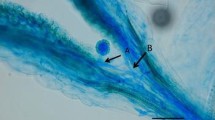Abstract
To assure self-compatibility in the progenies, three different crosses were conducted for the first time in an almond breeding programme: self-pollination (266 descendants from 30 families), crosses between parents sharing an S-allele (108 descendants from five families) and crosses with homozygous self-compatible parents (62 descendants from five families). Depending on the cross, self-compatibility in the progenies was determined by observing pollen tube growth (by means of fluorescence microscopy), stylar S-RNases analysis or allele-specific PCR. The results obtained fit with the accepted hypothesis of inheritance of self-compatibility and the three crossing strategies used ensured 100% of self-compatible descendants. These strategies increase the efficiency of the breeding programme and avoid the laborious task of evaluating this characteristic. From the breeding point of view, self-fertilisation and crosses between relatives tend to produce inbreeding. Furthermore, these methods reduce the possibilities of choosing the parental combination. The use of homozygous self-compatible parents does not have any of these disadvantages. As far as we know, this is the first time that allele-specific PCR has been used for early selection of self-compatible seedlings. The advantages and disadvantages of the three methodologies used to determine self-compatibility are discussed.

Similar content being viewed by others
References
Bošković R, Tobutt KR, Batlle I, Duval H, Dicenta F (1997a) Correlation of ribonuclease zymograms and incompatibility genotypes in almond. Euphytica 97:167–176
Bošković R, Tobutt KR, Rovira M, Romero M, Batlle I, Duval H, Dicenta F (1997b) Inheritance of stylar ribonucleases in two almond progenies and their correlation with self-compatibility. Acta Hort 420:118–122
Bošković R, Tobutt KR, Duval H, Batlle I, Dicenta F, Vargas JF (1999) A stylar ribonuclease assay to detect self-compatible seedlings in almond progenies. Theor Appl Genet 99:800–810
Burgos L, Ledbetter C, Pérez-Tornero O, Ortín-Párraga F, Egea J (1997) Inheritance of sexual incompatibility in apricot. Plant Breed 116:383–386
Burgos L, Pérez-Tornero O, Ballester J, Olmos E (1998) Detection and inheritance of stylar ribonucleases associated with incompatibility alleles in apricot. Sex Plant Reprod 11:153–158
Crane MB, Brown AJ (1937) Incompatibility and sterility in the sweet cherry (Prunus avium L.). J Pomol Hort Sci 15:86–116
Crane MB, Lawrence WJC (1929) Genetical and cytological aspects of incompatibility and sterility in cultivated fruits. J Pomol Hort Sci 7:276–301
Dicenta F, García JE (1993) Inheritance of self-compatibility in almond. Heredity 70:313–317
Dicenta F, Ortega E, Canovas JA, Egea J (2002a) Self-pollination vs cross-pollination in almond: pollen tube growth, fruit set and fruit characteristics. Plant Breed 121:163–167
Dicenta F, Ortega E, Martínez-Gómez P, Bošković R, Tobutt KR (2002b) Comparison of homozygous and heterozygous self-compatible seedlings in an almond breeding programme. Euphytica 124:23–27
Doyle JJ, Doyle JL (1987) A rapid DNA isolation procedure for small quantities of fresh leaf tissue. Phytochem Bull 19:11–15
Duval H, Grasselly Ch (1994) Behaviour of some self-fertile almond selections in the south–east of France. Acta Hort 373:69–74
García JE, Dicenta F, Berenguer T, Egea J (1996) Programa de Mejora del Almendro del CEBAS (CSIC-Murcia). Fruticultura Profesional 81:64–70
Godini A, Palasciano M (1997) Growth and yield of four self-unfruitful and four self-fruitful almonds onto three rootstocks: a 13-year study. Acta Hort 470:200–207
Gradziel TM, Kester DE (1998) Breeding for self-fertility in California almond cultivars. Acta Hort 470:109–117
Grasselly Ch (1985) Avancement du programme "autocompatibilité" chez l'amandier. Options Méditerr CIHEAM/IAMZ 85/I:39–41
Grasselly Ch, Olivier G (1981) Difficulté de survie de jeunes semis d'amandiers dans certains descendances. Options Méditerr CIHEAM/IAMZ 81/I:65–67
Grasselly Ch, Olivier G (1984) Avancement du programme de création de varietés d'amandier autocompatibles. Options Méditerr CIHEAM/IAMZ 84/II:129–131
Grasselly Ch, Olivier G (1988) Phenomènes d'inbreeding dans les descendances issues d'autofécondation chez l'amandier. 7 Colloque GREMPA. Trapport EUR 11557, 73–78
Grasselly Ch, Crossa-Raynaud P, Olivier G, Gall H (1981) Transmission du caractère d'auto-compatibilité chez l'amandier (Amygdalus communis). Options Méditerr 71–75
Lansari A, Kester DE, Lezzoni AF (1994) Inbreeding, coancestry and founding clones of almonds of California, Mediterranean shores and Russia. J Am Soc Hort Sci 119:1279–1285
Linskens HF, Esser K (1957) Über eine spezifische Anfärbung der Pollenschläuche im Griffel und die Zahl der Kallosepfropfen nach Selbstung und Fremdung. Naturwissenschaften 44:16
Martin FW (1959) Staining and observing pollen tubes in the style by means of fluorescence. Stain Tech 34:125–128
Rovira M, Clavé J, Romero M, Santos J, Vargas FJ (1997) Self-compatibility in almond progenies. Acta Hort 470:66–71
Socías i Company R (1984) A genetic approach to the transmission of compatibility in almond. Options Méditerr Serie Études 2:123–128
Socías i Company R, Felipe A (1977) Heredibility of self-compatibility in almond. 3e Colloque du GREMPA, Bari, pp 181–183
Socías i Company R, Felipe AJ (1988) Self-compatibility in almond: transmission and recent advances in breeding. Acta Hort 224:307–317
Socías i Company R, Felipe AJ (1992) Self-compatibility and autogamy in "Guara" almond. J Hort Sci 67:313–317
Sonneveld T, Robbins TP, Bošković R, Tobutt KR (2001) Cloning of six cherry self-incompatibility alleles and development of allele-specific PCR detection. Theor Appl Genet 102:1046–1055
Tamura M, Ushijima K, Sassa H, Hirano H, Tao R, Gradziel TM, Dandekar AM (2000) Identification of self-incompatibility genotypes of almond by allele-specific PCR analysis. Theor Appl Genet 101:344–349
Tao R, Habu T, Yamane H, Sigiura A, Iwamoto K (2000) Molecular markers for self-compatibility in Japanese apricot (Prunus mume). Hort Science 35:1121–1123
Vargas FJ, Clavé J, Romero M, Batlle I, Rovira M (1997) Autogamy studies on almond progenies. Acta Hort 470:74–81
Whitehouse HLK (1951) Multiple-allelomorph incompatibility of pollen and style in the evolution of the angiosperms. Ann Bot NS 14:198–216
Acknowledgements
This work has been financed by the project "Mejora Genética del Almendro" (AGF98-0211-C03-02) from the "Plan Nacional de I+D" of the Spanish Ministry of Education and Culture. We thank Dr. David Walker for revision of the English in the manuscript.
Author information
Authors and Affiliations
Corresponding author
Additional information
Communicated by H.F. Linskens
Rights and permissions
About this article
Cite this article
Ortega, E., Dicenta, F. Inheritance of self-compatibility in almond: breeding strategies to assure self-compatibility in the progeny. Theor Appl Genet 106, 904–911 (2003). https://doi.org/10.1007/s00122-002-1159-y
Received:
Accepted:
Published:
Issue Date:
DOI: https://doi.org/10.1007/s00122-002-1159-y




